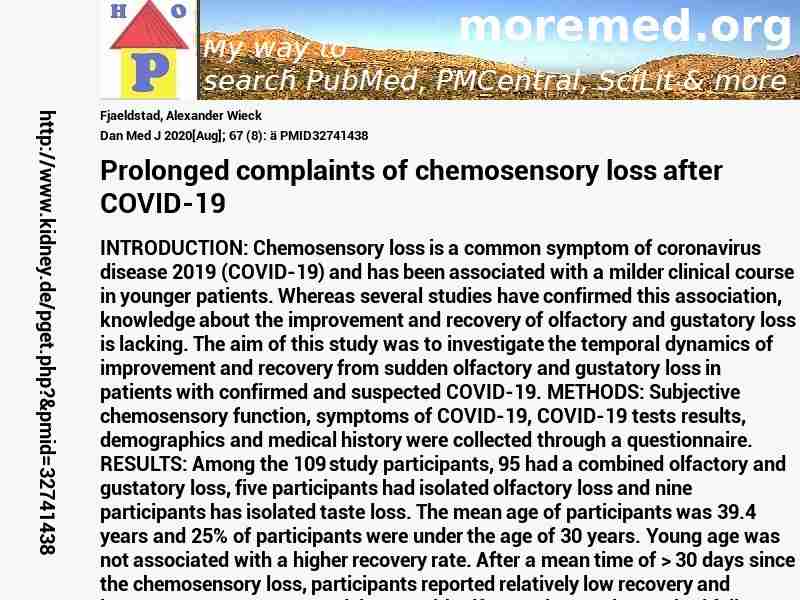
|
http://scihub22266oqcxt.onion/

32741438!�!32741438
Warning: file_get_contents(https://eutils.ncbi.nlm.nih.gov/entrez/eutils/elink.fcgi?dbfrom=pubmed&id=32741438&cmd=llinks): Failed to open stream: HTTP request failed! HTTP/1.1 429 Too Many Requests
in C:\Inetpub\vhosts\kidney.de\httpdocs\pget.php on line 215
|  
Deprecated: Implicit conversion from float 213.6 to int loses precision in C:\Inetpub\vhosts\kidney.de\httpdocs\pget.php on line 534
Warning: imagejpeg(C:\Inetpub\vhosts\kidney.de\httpdocs\phplern\32741438.jpg): Failed to open stream: No such file or directory in C:\Inetpub\vhosts\kidney.de\httpdocs\pget.php on line 117
 Dan+Med+J 2020 ; 67 (8): � Dan+Med+J 2020 ; 67 (8): �
Nephropedia Template TP
gab.com Text
Twit Text FOAVip
Twit Text #
English Wikipedia
|
Prolonged complaints of chemosensory loss after COVID-19 #MMPMID32741438Fjaeldstad AWDan Med J 2020[Aug]; 67 (8): � PMID32741438show ga
INTRODUCTION: Chemosensory loss is a common symptom of coronavirus disease 2019 (COVID-19) and has been associated with a milder clinical course in younger patients. Whereas several studies have confirmed this association, knowledge about the improvement and recovery of olfactory and gustatory loss is lacking. The aim of this study was to investigate the temporal dynamics of improvement and recovery from sudden olfactory and gustatory loss in patients with confirmed and suspected COVID-19. METHODS: Subjective chemosensory function, symptoms of COVID-19, COVID-19 tests results, demographics and medical history were collected through a questionnaire. RESULTS: Among the 109 study participants, 95 had a combined olfactory and gustatory loss, five participants had isolated olfactory loss and nine participants has isolated taste loss. The mean age of participants was 39.4 years and 25% of participants were under the age of 30 years. Young age was not associated with a higher recovery rate. After a mean time of > 30 days since the chemosensory loss, participants reported relatively low recovery and improvement rates. For participants with olfactory loss, only 44% had fully recovered, whereas 28% had not yet experienced any improvement of symptoms. After gustatory loss, 50% had fully recovered, whereas 20% had not yet experienced any improvement. Olfactory and gustatory deficits were predominantly quantitative and mainly included complete loss of both olfactory and gustatory function. CONCLUSIONS: Chemosensory loss was frequent in young individuals and persisted beyond a month after symptom onset, often without any improvement during this time. FUNDING: The author wishes to acknowledge research salary funding from Arla Foods (Viby, Denmark) and the Central Region Denmark. The sponsors had no say, roles or responsibilities in relation to the study, including (but not limited to) the study design, data collection, management and analysis. TRIAL REGISTRATION: not relevant.|*Ageusia/diagnosis/etiology/rehabilitation[MESH]|*Coronavirus Infections/complications/diagnosis/epidemiology/physiopathology[MESH]|*Olfaction Disorders/diagnosis/etiology/rehabilitation[MESH]|*Pandemics[MESH]|*Pneumonia, Viral/complications/diagnosis/epidemiology/physiopathology[MESH]|Adult[MESH]|Betacoronavirus/*isolation & purification[MESH]|COVID-19[MESH]|COVID-19 Testing[MESH]|Clinical Laboratory Techniques/methods/statistics & numerical data[MESH]|Denmark/epidemiology[MESH]|Diagnostic Self Evaluation[MESH]|Female[MESH]|Humans[MESH]|Male[MESH]|Recovery of Function[MESH]|SARS-CoV-2[MESH]|Surveys and Questionnaires[MESH]
  
DeepDyve
Pubget Overpricing | 
|